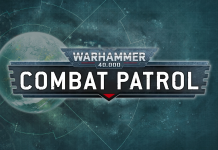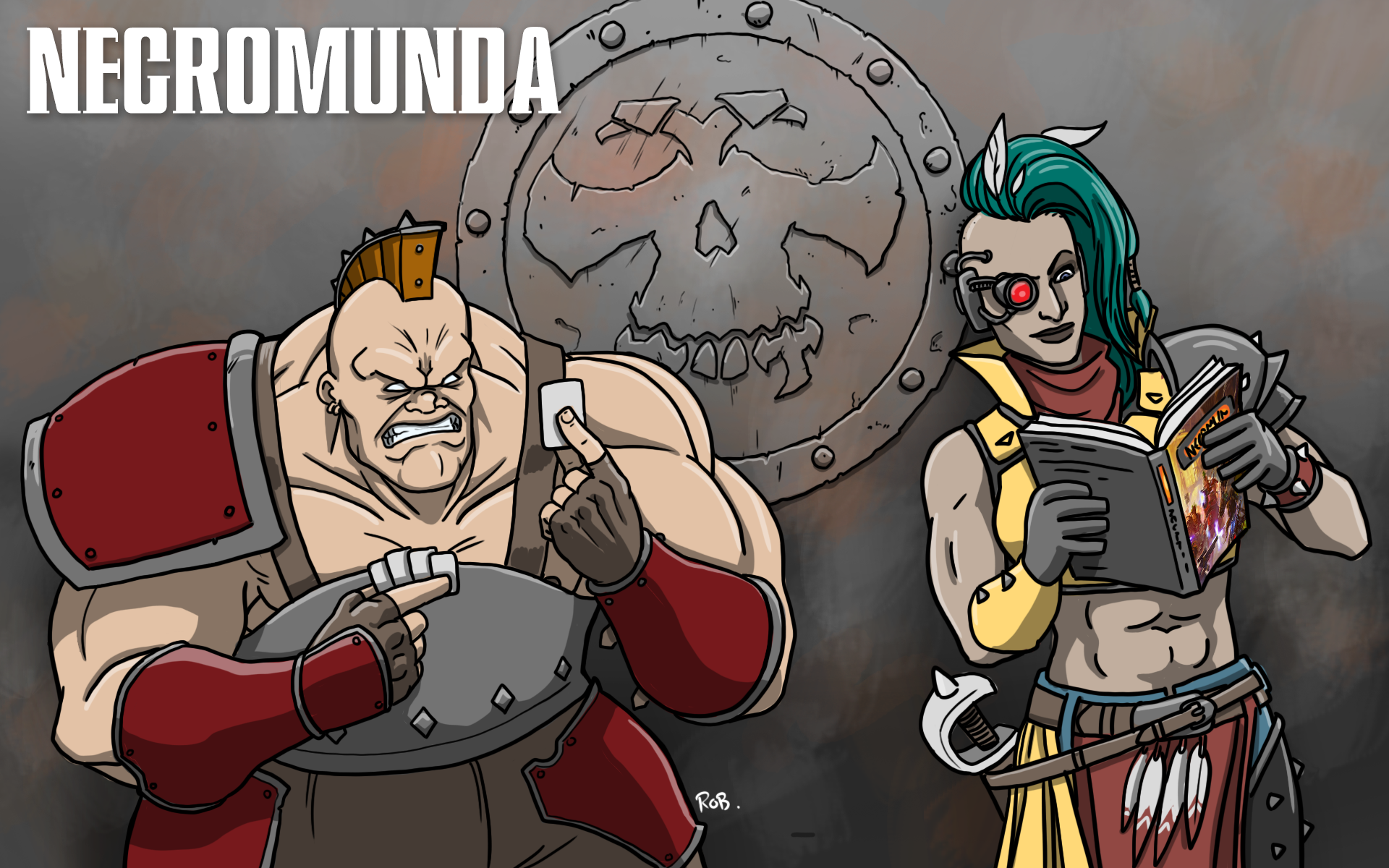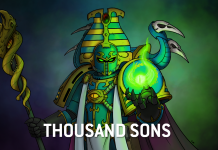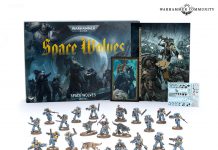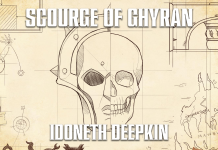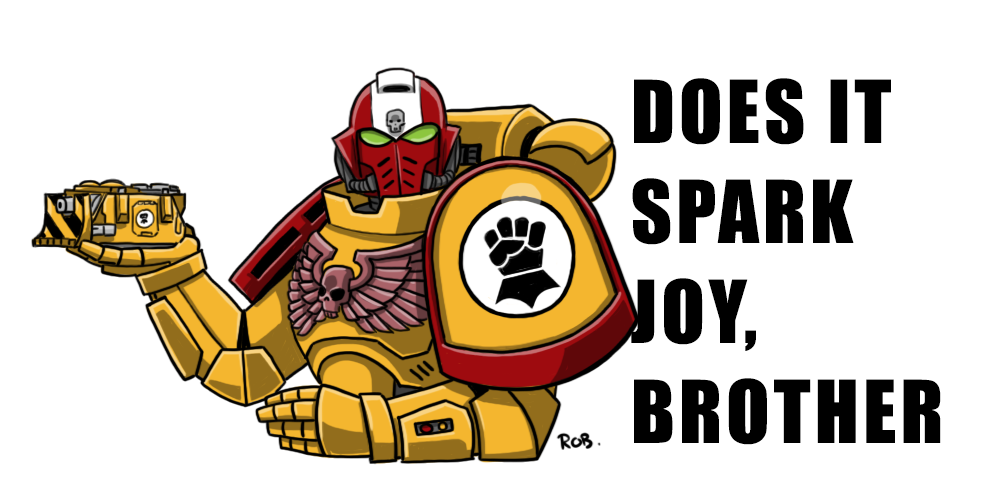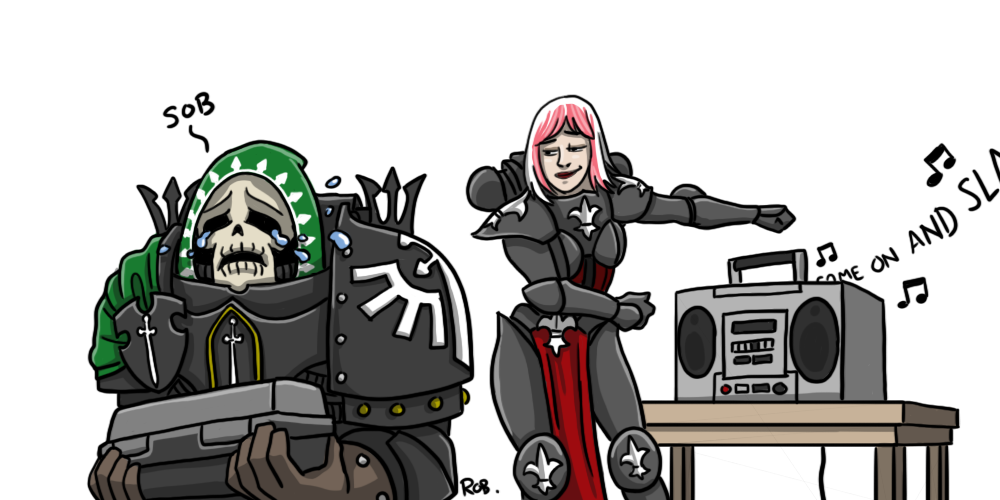So you’ve Brushed up on the basics, lovingly painted all of your little plastic mans, and studied your probability basics. You’ve got a few games under your belt, and you’re ready to take the next step. Maybe not play at competitive events, but start improving your game. You wanna be the guy blasting Space Jam to vanquished foes after the last battle round has ended. But maybe you’re not quite sure how to do that – what does better play look like? How do you know if a list you’ve built is good? How do you know if the pile of miniatures you lovingly painted are worth putting on a table?
Well, this article is for you. In this article, we’re going to cover the basics of good Warhammer play, from list-building basics to battlefield tactics. While we’ll cover the details of each specific army in an upcoming series of articles, today we’re going to cover the basic concepts that will help you across every army and in every game.
Generally, there are three major areas to think about where you can improve your game:
- Before the game (list building, unit selection, strategic planning)
- During the game (deployment, tactics, decision-making)
- After the game (losing graciously, learning from your mistakes, blasting Space Jam)
Before the Game
Improving at 40k starts long before the players sidle up to the table for the actual game. Depending on who you ask, many games are won or lost before they even begin. I’m of the mind that generally speaking, pre-game planning and list building accounts for about half of a player’s performance or chances of winning. Because of this, we’re first going to spend a bit of time diving into what you can do to improve your chances of winning before the first die is cast.

Building Lists
Better 40k starts with building better lists. While many players may overestimate the importance of an army list – they’re by no means the only factor in 8th edition 40k – bad lists can prevent you from being able to participate against a good list, and can lead to a real uphill battle if your list’s strategy plays right into your opponent’s. We’re not here to tell you that you can’t play with your favorite units because their numbers aren’t good enough, as you can happily still win with some sub-optimal units in tow, just how to avoid creating something that’s less than the sum of its parts.
So let’s talk about some things you can do to build better lists.
- Have a plan.
Building an effective list starts with having a plan. Ask yourself: How are you going to win? What does your army need to do to secure a victory, and what are the pieces you’ll need from your army to accomplish that?- Understand the mission you’ll be playing.
Before you start building a list, you need to know what your objectives are going to be. What kind of mission(s) are you going to play, and what does that mean for your army? Are you going to need to hold a small number of objectives for several turns to score progressively? Do you need to zip around the table to capture objectives you draw from Maelstrom of War? Even if you don’t know the *exact* mission parameters, you should consider the overall mission type, and what will be required of your army for that mission. - Think about what you’re likely to face.
While we wouldn’t necessarily advocate tailoring your list exactly to a single opponent, you should think about what you’ll be up against in your next game. Will there be lots of heavy armor? Do you need to fight hordes? You don’t want to go overboard here since your opponent can do the same and anticipate your strategy, but you should have a way to interact with what you expect to see on the table. - What is your army good at?
What makes your codex or the particular units you like init excel? In what situations are they going to outperform whatever pathetic challengers your opponent has brought to the table? How might you best be able to support these strengths?
- Understand the mission you’ll be playing.
- Visualize: What does victory look like?
Once you know the mission, build a plan for how you’re going to win. Recognize that no plan fully survives contact with the enemy, but visualize what victory looks like. After you’ve built your army, come back to this. Think about how the game should play out if everything went right. What might go wrong with that and lead to a loss? If you can’t create a good picture, it’s time to rework the army.
- Think about what your first turn looks like, and what you’ll be doing in each phase.
Think about the units you’re bringing or that you want to bring. What’s a good first turn look like? What are you doing in each phase of the game. Knowing this will ultimately help you play better as well.
- Maximize your Command Points.
There’s more to list-building than just getting as many CP as possible, but don’t leave CP on the table by trying to put everything in one detachment when you could use two. Command Points are the lifeblood of many armies and strategies, and help you smooth the variance over the course of a game with re-rolls and bonuses. As you build your list, think about how you can spread it across multiple detachments to generate more command points.
Early on, and particularly if you’re unsure of what you’re doing with army construction, we’d recommend that you start your list by filling out a Battalion, as this ensures you have at least a decent stockpile of CP. - Bring good units and give them good wargear.
This seems like a no-brainer, but I’m going to go into this in more detail below, in the sections named “Evaluating Units” and “Evaluating Wargear.” As a corollary to this, as you build lists, focus on tactics, buffs, and combinations that make good units great, not those that make bad units playable. - Double Down on your Strengths
For the most part, you’ll see more value from doubling up on good units rather than taking a diverse list. While you’re still getting into the swing of playing an army, you’ll probably get more benefit from adding more of the units you know are good rather than trying a lot of different things at once. Don’t avoid trying new things entirely, but if you have to pick three units to add to your list, choose two that you know are strong and one that’s a bit out-there. Doubling up on your best units also gives you redundancy in the case that you lose some of them early on, which will definitely happen in the lethal world of 8th edition 40k
Read the rules.
Know the rules, and the rules for your army. If you can, know the basic rules for your opponent’s army. Failing that, make sure you understand the rules interactions that are important to your strategy, and how they’ll impact the game. Have printed copies of the FAQs that you’re relying on, if necessary. Know how targeting, shooting, and combat work.
 Evaluating Units
Evaluating Units
While we’ll dig more into which of individual units for an army are good, less good, and outright bad in future articles that are specific to each army, there are a few things that you can think about to your options when you’re building a list or thinking about how to build an army that will help you build better armies.
As you consider a unit for your army, or just generally, consider the following:
- What is this unit’s purpose?
What’s the unit designed to do? What would it be doing in the game you’re planning to play? Is it an assault unit? Is it a long-ranged unit with heavy weapons? Is it just there to help fill out a detachment so you can get more CP? What’s the unit for. - How good is the unit at accomplishing that purpose?
If it’s an assault unit, how good is it at fighting the units you think it’ll be up against? More importantly, how’s it going to get into combat? Does it need a transport? Does it teleport in?
If it’s a shooting unit, what kind of guns does it have? Can it reliably kill or help kill the targets you expect to see on the other side of the table? If it’s there to fill out a detachment, is it as cheap as possible? Is it good at capturing objectives? Is it the best option?
- How expensive is the unit relative to other units in the army with that same purpose?
Ok, the unit serves a purpose, and you think it can accomplish that purpose reasonably. Next ask yourself: Is it the most efficient unit in the army for doing that? Is there a better option? Is there an equally good option that will work better when combined with my other units? This is where you might want to do some quick math to determine how murderous your unit is vs. its points cost.
- How does it fit into my strategy?
Think about your broader strategy. What is your army doing on the first turn? The second turn? How does this unit play into that? Does it make the units around it better? Do those units make it better? This is where you want to identify synergies and combos, or areas where your units and their abilities will complement each other and improve their function. You don’t have to build whole lists around synergies and combos, but they can be very powerful when you do. Just make sure you don’t create too many dependencies — You want strategies that work all or most of the time, as your army needs to work when things go badly, not just when they go well.
- Build a list that makes good units great, not bad units OK.
Now that we have a wealth of campaign supplements and books, there are a lot of buffs, special rules, and units out there that can help make other units better. Generally speaking, you want to build your strategy around making good units great, and not trying to elevate bad units to the point of playability. The question you want to ask in these cases is “would this unit be good to have if the units helping it died?” If the answer is no, then consider swapping it out.
As an example, Eldar Dark Reapers are great. They’re effective, cost-efficient, and they fill multiple battlefield roles. They’re good to have even in a vacuum, so when paired with abilities like Doom or Jinx, they become even better. By contrast, Chaos Space Marine Possessed are expensive, don’t have shooting attacks, have a small, variable number of close combat attacks, and generally do not do as much damage in close combat as you’d like. Although there are numerous units and abilities that buff them, they all require spending points and resources making a bad unit worth fielding. So you should avoid them in favor of better units, like Berserkers.
Evaluating Wargear
Evaluating units and wargear goes hand-in-hand, but generally you can use the dice math we’ve discussed previously to figure out wound output for a weapon against the most likely targets and use that to compare one weapon’s effectiveness to another’s. If you take the expected value of a weapon’s shooting and divide it by the weapon’s cost (or the minimum cost of fielding a unit, for built-in wargear), you’ll get a good measure of efficiency for the gun. Generally speaking though, here are a few guidelines for picking weapons:
- More shots is better
You want to avoid putting all of your eggs in one basket, mostly because variance is bad (see below). Generally speaking, 2-3 medium shots will be more effective in the long run than 1 big shot (Unless the shot is really, really big). If you have effects that boost accuracy or wound probability, the impact of these will be increased by a larger number of shots, giving you more bang for your buck.
- Think about the targets you’ll be shooting.
Your weapons don’t exist in a vacuum. Some guns are only good against hordes. Some are only good against large targets. Some aren’t really good against either, but can manage OK against both. You’ve already spent time thinking about the units you’ll be up against. Make sure you’ve got the weapons to take them down. This is particularly important with Knights. If you’re up against a knight, you better have a way to do 24 wounds to a T8 3+ unit in one or two turns, or you might be heading toward a bad time.
- Variance is bad
Variance, or the spread of values a die roll can take from its average, is generally bad. That is, if you can, you want to avoid weapons that can take a wider spread of values because even though they may have a decent average value for number of shots or damage, they’re going to feel very feast-or-famine on the tabletop. So similar to our more shots rule, we also generally want more dice. 2D3 is better than 1D6, not only because it has a higher damage value, but because the spread is lower. And even though the expected value of a D6 is 3.5, most of the time you’ll find that having a weapon do 3 damage is better than doing D6.
During the Game
- Read your Opponent’s army list. Talk to them about what’s in it.
Before every game, exchange army lists with your opponent. Talk to them about what’s in your army, what units you have, what detachments and factions they belong to, and how many CP you have. Run them through any crazy rules interactions you’re planning to use.
Likewise, talk to your opponent! Ask them about their army, get them to clarify what’s what on the table. And ask them about rules you are unclear on. I recommend something like “Hey, I’ve played against <ARMY> before, but it’s been a while. Can you give me a quick refresher on how <MECHANIC> works?” This establishes that you 1. Are not a gullible rube (even if you haven’t played against it, this will make a stranger less likely to take advantage of you), and 2. Are capable of the kind of sensible, adult communication that makes every game better.
Run through with your opponent what can infiltrate, what can teleport in, and any other deployment shenanigans to be aware of. This is where you want to fill in the gaps in your knowledge about what you’re up against. This is the information you’ll use to tailor your pre-game plan to the current game.
- Play the mission
You’ve got a mission to play. Maybe it’s Eternal war, maybe it’s Maelstrom. Maybe it’s a crazy narrative mission or you’re at NoVA or an ITC tournament. Either way, your victory will likely be dictated by more than just your ability to kill units. Familiarize yourself with the objectives and run through mentally how you’re going to accomplish them. - Adapt your plan and tactics to the game at hand
Going back to pre-game planning, have a plan and be ready to follow through on it. Figure out how to apply it to the opponent you’re facing and the mission you’re playing. Think about what your opponent can do to mess up your strategy. Remember always that this is a two-player game and that everything you do will be met with a counteraction from the other player. - Have a backup plan
No battle plan survives contact with the enemy. Across the table from you is a living, breathing person who is going to attempt to thwart your strategy at every turn. With some careful preparation, you can know what’s potentially coming ahead of time, and plan accordingly. But either way, you’ll need to adjust to what’s happening on the table.
Don’t over-commit to a strategy that isn’t working just because that’s the plan; be prepared to shift to a different or backup plan if it looks like that’s what’s called for. Avoid falling into the “sunk cost” fallacy where you feel too invested in one particular action or plan to pull out after it starts failing. In other words, if your plan to kill that knight isn’t going well, don’t keep flailing at it just because you’ve already invested resources in trying to kill it.
- Better Deployment
Deployment is one of the most important parts of the game, and will often set the stage for how the contest plays out. We could write an entire article just about deployment, which will vary by mission, army, strategy, and whether you are intending to go first or second, but for the time being we’ll settle on a few basics. Namely:
- Deploy as though you’re going to go second
Sometimes you’ll go first. Almost as many times, you’ll go second. You will usually be better off deploying as though you’re going to have the second turn, i.e. putting units in cover, placing them out of line of sight, protecting key assets than you will deploying as though you’ll have the first turn. Remember: Variance is bad, and going all in on having the first turn is a high-variance strategy. It either pays off big, or costs you gravely, with no in-between.
- Know when to Deep Strike and when to hoof it
Just because your unit can teleport or tunnel in doesn’t mean they should. If you’re going to use those rules to drop a unit in your opponent’s backfield, make sure there’s going to be a good place to do it, and make sure you couldn’t have just walked there. Think about what your opponent’s likely response to declaring a teleporting unit will be. Generally, you want to use deep strikes to get a slow unit across the board into a good position where it can either hold an objective or dish out a lot of pain.
What you want to avoid doing is overextending, and leaving your unit alone on the far side of the table where the opponent’s entire army, including units that can’t reach your main army, can suddenly shoot at it and wipe it off the board without consequence.
- Create reminders to avoid forgetting important actions
Don’t forget important rules, interactions, and phases!
If it seems like there’s a lot to keep track of and you find yourself missing a bunch of key events, I’ve created a helpful print-out you can use to keep track of the important events and rules you need to remember. Just print this sheet out and write down some notes about the rules you need to remember, the units you need to pay attention to, and the interactions that can trip you up.
Turn Reminders Printable file
- Alpha Strikes: Go hard early
Dead units can’t shoot back. Your opponent has a plan too. Ruin his plan early by crippling his army and its ability to enact that plan. The alpha strike is your army’s first big move, ideally done on the first turn, but not necessarily. If your army’s plan is to issue a strong, decisive strike early, then make it as strong and decisive as possible. Spend your CP, use your one-use abilities, and remove as much variance as you can. Generally, CP spent earlier will be more valuable than CP spent later.
- Don’t Overextend
Your army is at its most vulnerable when large groups of enemies can focus on a single unit at a time without having to worry about other threats. In these cases, enemies don’t have to worry about choosing between multiple threats and can devote all their efforts to wiping out a small number of targets, significantly weakening your army with no payoff.
- Focus your efforts
Likewise, take advantage of the chances to do this on your end. Focus on one or two major targets at a time and either remove them from the table completely, or cripple their ability to act in a meaningful fashion.
- Variance is bad… with one exception.
When you’re the overdog, or in an even matchup, variance is bad. It can ruin plans and leads to lots of crazy outcomes. When you’re the underdog, though… well in those cases variance is your friend. If you’re significantly outmatched, outgunned, or outwitted by the opponent, then high-risk, high-reward strategies will be a bigger benefit to you than they would your opponent and while you are likely to lose with them, you were likely to lose without them. - Don’t drink too much
Have some beers or what have you, cause that’s how the game was intended to be played, but don’t make a mess or become a liability.
After the Game
- Be gracious in defeat.
Look, it’s just a game. You’re going to lose a lot of them. Remember that you had a living, breathing person across from you who spent the entire game trying to stop your plan from succeeding. It’ll happen. And most of the time, it won’t be just because of the dice. It’ll be because of something they did. Or something you did. Probably both. Just be cool about it. If you’re really upset, just move on. Don’t blame the dice, don’t get salty and insult your opponent. Don’t ruin their moment. Offer a handshake, say “good game,” and try and get out of there without running your mouth. You can’t win after you’ve lost the game and nothing you say is gonna change that.
That said, I acknowledge that this can be easier said than done. If you get salty from losing from time-to-time, I get it. But if you do, apologize, and work on improving. Or else no one is going to want to play you and you’re gonna end up being That Guy That People Talk About on Forums Later. - Seriously, don’t blame the dice.
It’s almost never the dice. Nine times out of ten, if a die roll fucked you, it’s because you put yourself in a situation where the game depended on a single die roll. And as we’ve said before, variance is bad. Even if you’re absolutely sure that it was the dice, are there places you could have done better?
- Don’t be a dick if you won, either.
I mean, don’t be too much of a dick. How much you gloat should depend on how well you know the other person and how angry they are. If you know them well and they’re in good spirits, the proceed immediately to blasting Space Jam (see below).
- Talk about what happened.
Do a postmortem. Think about what worked, what didn’t. Talk to your opponent. Get their thoughts on the game. Think about what you did that was a mistake. Did you overextend? Overplay your hand? Why did you opponent do what they did? This is a good time to learn and improve.
- Think about the next game.
Think about how you’d have done things differently. Think about what in your list pulled its weight, and what did not. Think about your plan. How did it hold up? Do you just need some tweaks? Or is it time to scrap everything and go back to the drawing board. This is where you need to be honest with yourself – practicing with a list is the best way to improve, so you don’t want to waste too many games on something unsalvageable.
- Burn the building down.
Leave no survivors to spread word of your failure.
One_Wing’s Note: Remember to transfer your models to their movement tray and evacuate them first. Models are expensive.
Blasting Space Jam: When Should You Do This and For How Long
Immediately after a win and repeatedly until your opponents leave in disgust, swearing never to return. The volume should be loud enough to drown out the sounds of their salty bullshit.
Putting This to Use
I’m not going to pretend that you’re now equipped with everything you need to know to improve your game, but if you do even half of this stuff, you’ll find yourself winning a lot more games and enjoying the games you play in (even the losses) a lot more.
If you’re interested in where to go from here, keep an eye out for future Goonhammer tactics articles. We’ll cover preparing for competitive play next, and in our series on individual factions, we’ll cover each of the game’s factions in detail, going through the key units, strategies, and army builds that make best use of that faction’s strengths.

